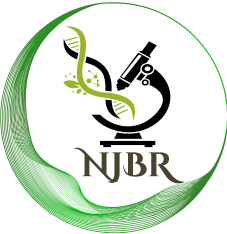Comparative Mosquito Repellence Potential of the Extracts of Citrus sinensis peels and Cochlospermum planchonii leaf
Keywords:
Mosquito, Repellence, Phytochemicals, Citrus sinensis peels, C. planchoniiAbstract
The use of chemicals in pest control has been associated with several human health risks, and that of the environment. An alternate approach is the utilization of natural products from plants. This study evaluated the potential of the extracts of Citrus sinensis peels and Coclospermum planchonii leaves in mosquito repellence. The essential oils of the plant materials were extracted from 300 g each of the ground samples using the soxhlet extractor at 70-800C. The extracted oils were screened for the presence of bioactive compounds; and were applied on the uncovered skin of the hands, legs and faces of 48 human volunteers at 10, 20 and 30% concentration levels. The volunteers were observed for 12 hrs and observations were recorded at 30 minutes interval. The result of phytochemical screening showed the presence of flavonoids, tannins, carbohydrates and steroids in the extracts. The potential of the extracts in repelling mosquitoes showed higher repellence activities at 30%. The Time before Bite (TbB) observed for C. sinensis was 332.10±17.87 min i.e. 5.54 hrs) (P = 0.000). The highest number of bites (NoR) (19.17±2.4) on the other hand was observed in the Control group, while the least was observed at 30% (2.33±0.82) (P = 0.000). The TbB for C. planchonii at 30% extract was observed to be 341.64±16.61 min i.e. 5.61 hrs (P = 0.000), while the NoR which was the least was 2.17±47 P = 0.000). The comparative repellence activities of the extracts showed no significant main effect with respect to TbB (F (1,35) = 0.230; P = 0.635), as well as the NoR ((F (1,35) = 1.563; P = 0.219). The extracts showed great potential for use as bio-control agents against mosquito bites. Further studies should be conducted for effective utilization.
References
Alain, A., Mamidou, W.K., Benjamin, G.K. and Honora, F.T.B. (2013). Larvicidal potential of some plants from West Africa against Culex quinquefasciatus (Say) and Anopheles gambiae Giles (Dipthera Culcidae). 1UFR Sciences of Nature, University Nangui Abrogoua, Abidjan, Cote d’Ivoire. Vector Borne Diseases, 50: 103-110.
Bossou, A.D., Manggelinck, S., Hounnankpon, Y., Pelegie, M.B., Martin, C.A., Dekimpe, N., Felicien, A. and Dominique C.K. (2013). Chemical composition and insecticidal activity of plant essential oils from Benin, against Anopheles gambiae, Giles. Parasites and Vectors, 6:337.
Effiom, O. E. Avoaja D. A. and Ohaeri, C. C (2012). Mosquito Repellent Activity of Phytochemical Extracts from Peels of Citrus Fruit Species. Global Journal of Science Frontier Research Interdiciplinary. 12:2249-4626
Govindarajan, M. (2010). Larvicidal efficacy of Ficus benghalensis L. plant leaf extracts against Culex quinquefasciatus Say, Aedes aegypti L. and Anopheles stephensi L. (Diptera: Culicidae). European Review for Medical and PharmacologicalSciences, 14:107-111
Gumilar, A.N., Yesi, D., Fahleni, F., Lhu, L. and Mira, A. D. (2023). Enhanced Efficacy of Kaffir Lime (Citrus hystrix) Essential Oil Spray Gel Against Aedes aegypti Mosquitoes. Journal of Natural Product for Degenerative Diseases. 1(1): 19-22
Gutierrez, P.M., Antepuesto, A.N., Eugenio, B.A.L. and Santos, M.F.L. (2014). Larvicidal activity of selected plant extracts against the dengue vector Aedes aegypti mosquito. International Research Journal of Biological Sciences, 3(4):23-32.
Hamaidia, K. and Soltani, N. (2014). Laboratory evaluation of a biorational insecticide, kinoprene, against Culex pipiens larvae: effects on growth and development. Annual Research & Review in Biology, 4:2263-73.
Janakiraman Narayanan and Johnson Marimuthu alias Antonysamy (2017). Larvicidal potential of Cyathea species against Culex quinquefasciatus. Pharmaceutical and Biomedical Research, 3(1): 48-51
Kontagora, G.F, Lawal, N., Adebote, D.A., Kamba, B., Nafiu, M.I. and Jumare, A. I. (2020). Some Preliminary Phytochemical Screening and Assessment of Four Solvents Extracts of Button Weed (Borreria verticillata). Journal of Applied Sciences and Environmental Management, 24 (12) 2085-2088
Lamien-Meda, A., (2015): APPEAR – Participative knowledge production through transnational and transcultural academic cooperation, Böhlau Verlag Wien Köln Weimar, Wien, 208-209.
Musa, D.D., Sangodele, F. and Hafiz, S. (2019). Phytochemical analysis and antibacterial activity of orange (Citrus sinensis) peel. FUDMA Journal of Sciences (FJS), 3:(1): 375-380.
Orwa C.A., Mutua K.R ., Jamnadass, R. and Anthony, S. (2009). Agroforestree Database: a tree reference and selection guide version 4.0 (http://www.worldagroforestry.org/sites/treedbs/treedatabases.asp)
Perez, R.P., Bujaidas, E.M., Cadena, S.R., Jasso, M.D., Gallaga, J.P., Miranda, A.S. (2005). Genotoxic and cytotoxic studies of betasitosterol and pteropodine in mouse. Journal of Biomedicine and Biotechnology, 3:242-7.
Rahuman, A .A., Bagavan, A., Kamaraj, C., Vadivelu, M., Zahir, A.A., Elango, G, (2009). Evaluation of indigenous plant extracts against larvae of Culex quinquefasciatus Say (Diptera: Culicidae). Parasitol Res. 104:637–43
Udeozo, I.P., Akpaba, E.S., Ugwu Okechukwu, P.C., Okoye, N.H. and Umedum, N.L. (2013). Qualitative Alkaloidal analysis of some Nigerian Medicinal plants used in herbal treatment of diseases. International Journal of Life Sciences Biotechnology and Pharmaceutical Research, 2(3): 300-305.
Ushie, O.A, Onen A.I., Ugbogu, O.C., Neji, P.A. and Olumide, V.B. (2016). Phytochemical Screening and Antimicrobial Activities of Leaf Extracts of Swietenia macrophylla. Chemistry Search Journal, 7(2): 64 – 69
Zoubiri, S. and Baaliouamer, A (2014). Potentiality of plants as source of insecticide principles. Journal of Saudi Chemical Society, 18:925–938.

Downloads
Published
How to Cite
Issue
Section
License
Copyright (c) 2025 Patrick Ode, Eric Gabriel Obochi, Suurshater Indyer, Cecilia Ogbenyi Ode

This work is licensed under a Creative Commons Attribution 4.0 International License.
-
- Attribution: You must give appropriate credit, provide a link to the license, and indicate if changes were made. You may do so in any reasonable manner, but not in any way that suggests the licensor endorses you or your use.
- No additional restrictions: You may not apply legal terms or technological measures that legally restrict others from doing anything the license permits.




